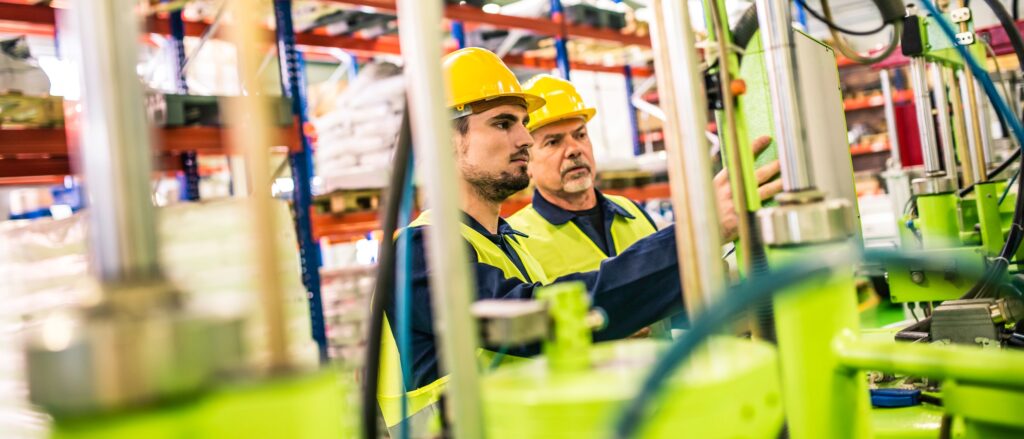LEARN WHY THE RPA PROCESS IS USED SO FREQUENTLY BY TOP MANUFACTURERS AROUND THE GLOBE
WHAT IS THE RAPID PLANT ASSESSMENT PROCESS?
The Rapid Plant Assessment (RPA) process is a manufacturing plant assessment tool developed by Dr. R. Eugene Goodson in 1998 while he led operations at Johnson Controls’ automotive seating business unit. During his time at Johnson Controls, Dr. Goodson grew the business unit’s revenue by over 8X, helping Johnson Controls achieve more scale and efficiency as a Tier 1 automotive supplier. Since the RPA process was developed, it has become a widely used process for quickly assessing a plant’s performance from a lean, operational perspective.

In the few years after the RPA process was developed, it was used in over 400 companies across 150 manufacturing and service industries from automotive suppliers, aerospace companies, book manufacturers, and microbreweries around the world. Lockheed Martin, Seagate Technology, Johnson & Johnson, and Eaton Corporation are among the growing list of companies that use the RPA process as a tool in their lean assessment. The RPA process is now widely known and used across many more industries and companies since its development.
What makes the process so attractive to plant leaders is its robustness, applicability to many types of facilities, and rapid effectiveness. A successful RPA process starts with a plant tour that can be conducted in as little as 30 minutes. 2 assessments are completed after the tour; the results from these assessments are the core value of the RPA process. These results give plant leaders an accurate gauge of the plant’s strengths and weaknesses, initiating a process to determine where further analysis or improvements should be made. The analysis can also serve as a benchmark from which to start measurable, lean process improvements.
The RPA process can also be used to effectively evaluate a competitor or potential partner’s plant. Whether for a strategic acquisition or supplier analysis, the RPA process is a quick way to gather information about the strengths and weaknesses of an unfamiliar facility. Many companies use this process to narrow in on their short list to determine which companies merit a targeted due diligence effort, rather than potentially wasting time and resources on detailed evaluations across a broad list of plants.
Although the RPA process does provide a comprehensive summary of a plant’s condition and efficiency, it is a starting point in the plant’s lean transformation journey. This assessment should not replace due diligence and investigation into a plant’s operations, but rather, it should serve as a gauge to identify which areas of operation require more focus, investigation or improvement. Regularly assessing your plant is necessary to continuously improve operations, but more importantly, that assessment will need to be turned into a plan-of-action to reduce downtime, improve efficiency, lower inventory turnover, and maintain high-quality production.
WHEN SHOULD YOU GET STARTED WITH THE RPA PROCESS?
Before routinely using any kind of plant assessment process, a plant’s commitment to high-quality production should be at the forefront of a plant leader’s agenda above all else. Once you have identified the level of quality required to sell your product (cost, customer satisfaction, and competitor quality), then it makes sense to start using the RPA process. After a commitment to quality has been made, the RPA process will help you identify what areas of operation are experiencing unnecessary downtime or inefficiency; lean improvement plans can be developed from there. However, without an initial commitment to quality, the RPA process will only help you lean out operations to make more poor quality product, faster.
WHAT YOU CAN LEARN FROM THE RPA RESULTS?
There are 2 components to the results from the RPA process, the rating assessment and the questionnaire. The RPA rating assessment grades plants across eleven specific categories in a refined, robust, and efficient way. The assessor grades each category on a scale of 1 to 6, from “Poor” to “Best in Class”. The final tally of each grade highlights the strengths and weaknesses of the plant. The questionnaire is comprised of 20 simple yes or no questions. The results from this questionnaire give an indication of a plant’s leanness; the more yeses, the leaner the plant.
HERE IS A SAMPLE OF WHAT YOU CAN LEARN FROM THE RPA RESULTS:
- Customer Satisfaction (Category 1): Plant leaders should seek the input of their customers and care for the customer should be apparent, even during a quick plant tour. How a customer is treated and how they feel when walking through a plant, and in interactions with plant floor staff, is an indicator of how committed the employees are to maintaining quality production. Customer considerations should be incorporated into plant operations in order to guarantee a commitment to customer satisfaction and loyalty throughout the organization from start to finish.
- Use of Floor Space, Movement of Materials, and Product Line Flow (Category 5): This category yields valuable operational efficiency insights, especially for a plant on a lean transformation journey. Product flow and movement through various lines and procedures are extremely important to maintaining efficient resource allocation, timely execution, and high product quality. The RPA results will help plant leaders identify workflow bottlenecks and initiate a discussion about the underlying causes of those bottlenecks. Plant leaders will usually know that there is a backlog in their floor, but not always know the reasons why. The RPA results help identify the reasons for the backlog and how to resolve the issue(s) creating the bottleneck(s).
- Condition and Maintenance of Equipment and Tools (Category 8): This category analysis provides insight into the apparent condition of tools and equipment. These insights assist plant leaders in developing improvement plans for workflows where tools and equipment are contributing factors to the occurrence of bottlenecks. Plant leaders can also use this information to prioritize where tool and equipment investments dollars can be allocated based on short and long-term goals of the organization.
HOW CAN YOU LEVERAGE THE RPA PROCESS?
If you’re interested in leveraging the RPA process for your organization, or to help you evaluate suppliers, acquisition targets, or competitors, The Phoenix Group can help your team with RPA process training and execution. We offer on-site training in the US, as well as online training in the US and globally.
In addition to RPA process training and execution, here are other benefits your organization can get from partnering with The Phoenix Group on incorporating the RPA process into your operations:
- Standardize Evaluation and Results: To ensure your organization gets the most accurate analysis from the RPA results, we’ve standardized the assessment measurement criteria so that analysis and comparisons are consistent. Without standardization across categories, plants, and industries, the results of an RPA will not be as useful in creating a plan-of-action for improvement.
- Create a Plan for Plant Optimization: The RPA process is also only valuable if the results are analyzed and used to create an action plan for improvement. Our team of operational experts will work with your team to create a comprehensive improvement plan from the RPA results specific to your organization. For process-driven organizations, having a clear, well defined, and realistic plan is the surest way to guarantee your organization achieves its goals.
- Execute on Plant Optimization Plan: Many of our clients also leverage The Phoenix Group’s expertise to ensure successful execution on their improvement plan. Our team has nearly 30 years of experience that your organization can leverage across many areas, including:
- Team & Leadership Development
- Project Management
- Lean Management & Six Sigma Training (including Black Belt & Master Black Belt Training)
- Quality Systems
- Formability Systems
- Die Skills Training
- Logistics
- Advanced Materials Joining
- Benchmark Across Industry: Another benefit you can get from the RPA results in partnership with The Phoenix Group is learning how your organization compares within your industry in terms of competitiveness, leanness, and efficiency. Many of our clients have leveraged this information as an opportunity to identify where their competitive gaps are. If your organization has room for improvement, leveraging the RPA process can put you on the path to turning your competitive gaps into your competitive edge. For industry leaders, this information is used to win new business by helping organizations articulate to prospects exactly how they stand out among competitors in the market.
If you are a long-standing Phoenix customer or have heard of us in the industry, you probably know us for one of our many services. The Phoenix Group may be your go-to experts for a particular area of your operations. We’ve delivered the highest standard of industry consulting for nearly 30 years, helping organizations achieve operational excellence across many areas, including quality operating systems, waste reduction, process control, throughput improvement, team processes, and organizational development. Let’s discover what opportunities there are for your organization to achieve the goals it strives for, starting with a Rapid Plant Assessment.


